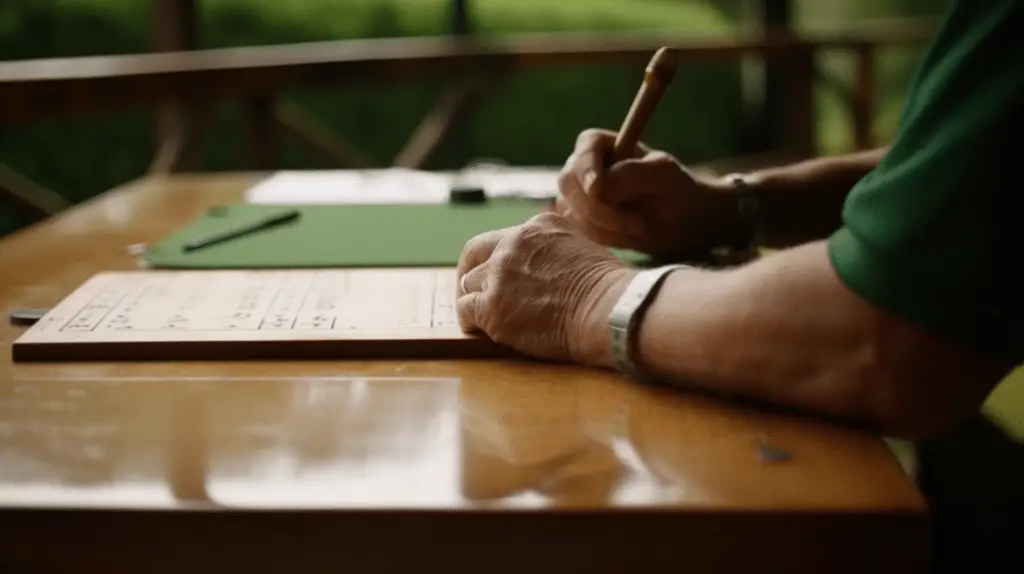Last Updated on June 12, 2023
Golf is a wonderful game that can be enjoyed by players of all skill levels. It’s an exciting way to spend time with friends and family, or even just to relax and play some competitive solo rounds. One important aspect of the game is keeping score, which for many golfers means tracking their scores on a Stableford Score Card. If you’re new to golf, learning how to fill in a Stableford Score Card may seem like a daunting task – but don’t worry! This article will explain step-by-step everything you need to know about properly filling out these cards accurately and quickly. We’ll cover what information needs to go where and why it’s important, as well as any extra tips that could help make your experience smoother and more enjoyable. So if you’re ready to learn how to fill in a Stableford Score Card correctly, let’s get started!
Overview Of The Stableford System
The Stableford System is a type of golf scoring system that’s used in many tournaments and club competitions. It rewards players for exceptional play while still providing an opportunity to compete fairly with players of different skill levels, thanks to the use of each player’s personal handicap. Players are awarded points based on their score relative to par, making it easier to identify who had the best performance overall – even if they didn’t get the lowest gross score. The system enables those with higher handicaps to hold their own against more experienced or skilled players. Every hole has its own point total associated with it; thus, the final result is determined by adding up all of these individual scores at the end of the course. This makes playing competitively much simpler and enjoyable, as everyone can easily see how well they’re doing compared to others – regardless of their handicap. In addition, this format also helps reduce pressure when competing since there’s no need for any extra calculations after finishing each hole. All in all, the Stableford System provides a great way for golfers of varying abilities to come together and have fun while enjoying some friendly competition.
Understanding Handicaps And Differential Scores
A player’s handicap calculation is based on their last 20 total rounds played, with an emphasis on recent performance. This score is then used in conjunction with the course ratings and slope values to determine what your Stableford handicap should be for any given round.
Differential scores are calculated by subtracting the Stableford handicap from the actual score earned during each hole. These differential scores are then totalled up to give an overall result for the entire round. The higher the number, the better, as this indicates a good performance from the golfer.
Here are four key points to remember when calculating a golfer’s Stableford handicap:
- Handicaps are based on past performance over several rounds
- Course rating & slope must be taken into account when determining a player’s Stableford handicap
- Differential scores compare a golfer’s actual score against their expected score
- Higher differentials indicate better performances throughout individual holes
How To Calculate Score For A Hole
In golf, the Stableford score is calculated for each hole. This system awards points according to how many strokes are taken on a given hole. Points are awarded based on an ascending scale from 0 up to 8 or 10, depending on the course and level of difficulty.
| Strokes Taken | Score Awarded |
|---|---|
| 0-2 | 8 |
| 3-4 | 6 |
| 5-6 | 4 |
| 7 | 2 |
| 8+ | 0 |
For example, if a player takes four shots on the first hole, then they would receive six points in their Stableford score calculation. A par three will usually yield two points while scoring a double bogey (two over par) results in zero points. In order to calculate your overall Stableford score, you need to add all of the point values for each individual hole together at the end of your round. The highest possible total is generally 40 or 80, depending upon whether it’s an 18 or 36 hole competition, respectively.
Your final tally determines how well you have performed within that particular field. It can be used as either a standalone handicapping system or alongside other more traditional techniques, such as gross scores and net scores, when playing competitions with friends and colleagues. Ultimately, knowing how to calculate Stableford scores gives players an easy way to measure progress throughout a game of golf and make sure they’re getting better every time they play!
How To Mark Your Card

When you have completed your round of golf, it is time to mark your card. To do this, simply add up the points for each hole and write them on your stableford scorecard. After adding up all the individual holes’ scores, you will be able to calculate your total score.
The way in which a player’s score is calculated depends upon their handicap – if they have one. If not, then no adjustment needs to be made when working out their final score; otherwise, an adjustment should be applied according to the player’s handicap rating. Once all adjustments are taken into account, there should be a final figure that can be used as the overall score. This will give you an indication of how well you performed during your game of golf!
Maximum Score For Each Hole
The maximum score for each hole in a Stableford golf scorecard is determined by par. A player’s points are calculated by subtracting their hole score from the par of that particular hole and then adding two to it. For example, if you hit an 8 on a par 5, your total stableford points would be 3 (5 – 8 + 2). It’s important to remember that any scores above double bogey don’t contribute any more points; so, even if you get an eagle or birdie, the most points you can receive is 6.
It’s essential to correctly record all individual hole scores when filling out a Stableford golf scorecard, as these will determine the maximum number of available points per hole. With this knowledge in hand, players can better judge how aggressively they can play a given shot in order to maximize their chances of achieving top point totals in every round.
Common Mistakes When Filling In A Scorecard
When filling out a Stableford golf scorecard, there are common mistakes to avoid. Scoring mistakes occur when points for each hole are not entered correctly; gross scores should be converted into net scores with the correct handicap taken into account. Marking errors can also lead to an incorrect total on the scorecard if not scored accurately – ensure that you enter all boxes and subtract any penalty strokes given. Handicap miscalculations may result in lower scores than recorded if your true handicap is higher than what has been used on the scorecard. Never guess or estimate how many shots have been taken during a round, as this could impact your final tally too. Therefore, it’s important to double check all calculations before submitting your completed scorecard at the end of the game. To keep track of every shot throughout your game, it is best practice to record them on a separate sheet of paper so that you don’t forget or make any other mistakes along the way. This will help minimize potential errors and maximize accuracy when completing your golf scorecard at the end of the play.
Conclusion
In conclusion, playing a Stableford game of golf is quite different to the regular scoring system used in other rounds. It requires players to be aware of the special rules and maximum scores for each hole, as well as to understand how their score will affect their overall total. With more than two players participating in a round, it’s also important to keep track of individual scores so that everyone can receive an accurate final result at the end.
Overall, we’ve seen that using a Stableford scorecard while playing golf can provide an interesting challenge and add some extra excitement to your game. While there are no penalties for going over the maximum score on a hole, you should still aim to stay within this limit if possible – otherwise, you could find yourself with a far lower final tally than expected! Finally, although it’s not necessary for tracking handicaps, many golfers choose to use Stableford points when calculating their performance level.
By taking all these factors into account, any golfer can make sure they enjoy the most out of their next round by utilising the Stableford scoring system. So why not give it a go today?



